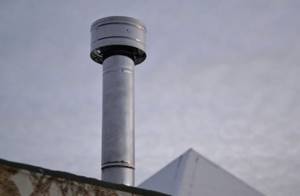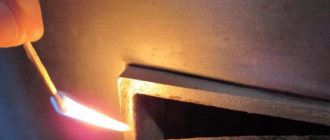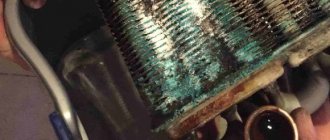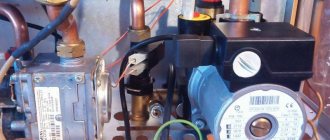Backdraft in the combustion chamber of gas boilers, which occurs during gusts of wind, is a fairly common problem. A gas boiler periodically goes out during strong gusts of wind, which impairs its efficiency; due to frequent shutdowns, it reduces its service life, and models with manual ignition have to be constantly re-ignited.
This problem occurs in floor-standing boilers with an open combustion chamber with a vertical chimney, and in boilers with a closed combustion chamber with a coaxial chimney. However, correcting the situation in more than 90% of cases is not difficult.
Diagram of air movement in gas boilers
Reasons for the boiler being blown out by the wind

If in apartment buildings the heating system is mounted in a coaxial air duct, which prevents wind from entering it, in private houses the problem of attenuation during strong gusts occurs quite often.
This is due to the design features of the chimney, as well as predisposing factors:
- There are trees near the air duct - with strong gusts of wind, vortex gusts are created that change the draft in the chimney, which leads to vibrations of the burner wick and, accordingly, the flame disappears.
- The predominance of downward wind flows, as well as the incorrect level and height of the chimney - this is especially true for lonely private houses (dachas, cottages), next to which there are no other buildings.
- Insufficient chimney height , at which a gusty wind easily extinguishes the burner flame.

- Malfunction of the draft sensor , which gives false readings, triggering the operation of the automation, blocking the supply of gas to the combustion chamber.
- Depressurization of the chimney , in particular an open inspection hole, which forms a reverse draft and triggers draft control sensors, which signal the need for an emergency shutdown of the gas supply to the system.
- Incorrect chimney design , when the required number of turns is missing and the wind from outside easily enters the boiler.
Also, the cause of boiler extinguishing in strong winds can be reverse draft. If the boiler is installed near a balcony door, in a gusty wind, when the door is open, a strong draft will be created, which will lead to vibration and extinguishing of the wick.
Boiler attenuation due to reasons within the system and their elimination
The most common reason for a boiler to go out is a lack of oxygen to the burner. This malfunction is inherent in economy class models, which are purchased more often than others. Expensive boilers have a special exhaust device that multiplies the air flow, maintaining combustion in all weather and internal conditions.
Lack of oxygen is a common cause of soot and gas burner extinguishing. The fire goes out because the missing air flows are captured from all the holes, the flame moves, the temperature of the thermocouple drops and the protection turns off the burner as if the temperature had reached the maximum value. Other reasons for the boiler burner to go out:
- In gas boilers with a turbocharger, a built-in electric fan helps pump air. If it does not work correctly, the burner may also go out. It's easy to diagnose a fan - when it's off, it continues to make noise.
- A non-functioning draft sensor is another reason for the boiler to fade. It should turn on if the temperature in the smoke catcher rises from hot steam, which for some reason did not enter the chimney.
- The burner does not ignite or burns poorly - the nozzles are clogged. Clean them with a brush or wire of the appropriate diameter.
- If air enters the boiler gas pipeline, the boiler operation is blocked and an error appears on the display. The reason why a gas boiler goes out can be easily eliminated - you need to start the boiler again, first unlocking it according to the instructions.
- During operation of the boiler, the gap in the igniter may be damaged or contact with the wire may be broken, or the air filter on the air line may become clogged. It is almost impossible to restore the gap with your own hands - you need the help of a gas specialist. But you can clean the filter and check the reliability of the connection of the current-carrying conductor yourself.
- The gas burner may not go out immediately, but after several minutes. The reason most often lies in contamination of the ionization electrode. Also, the correct gap in the electrode could be broken, or the connecting wire could fall off due to constant heating.
- The flame breaks away from the burner and goes out. Usually, the injector begins to make noise and whistle. The malfunction is eliminated by adjusting the gas pressure on the ignition electrode. The flame can break off if the draft is very strong - this phenomenon occurs with strong supply and exhaust ventilation.
- If the boiler is installed in a private house, then the flame may die out if the chimney pipe is installed very high.
- Spontaneous shutdown of the boiler, accompanied by strong noise, occurs due to a non-working pump or fan (explained above). A non-working thermostat causes the water to boil, followed by the flame breaking off.

If the voltage in the network fluctuates and decreases, the boiler burner may go out - the automation is activated, which recognizes the low voltage. After the power is restored to normal, the protection turns the boiler back on, so most of these cases go unnoticed. However, unstable voltage has a negative impact on the operation of electronic protection systems.
Attention: To avoid possible damage, it is better to use. .
And a very obvious reason for the burner to go out is low gas pressure in the line. This trouble can happen not only due to breakdowns in the external gas pipeline, but also due to internal problems.
- There is a malfunction in the gas meter. Check visually whether the mechanism is working and whether the numbers on the display are jumping. Even if this is the case, the malfunction may be delayed - and the meter is often noisy.
- Gas workers require the installation of monitoring equipment - gas leakage sensors and temperature sensors. They monitor compliance with the regimes around the boiler. When the sensors are triggered, the boiler turns off.
- The connections in the gas pipeline are leaky. A gas leak means low pressure, so the automation reacts immediately and the boiler turns off. If there is no leak sensor, then this type of malfunction is determined by the smell of gas. To identify the malfunction and eliminate it, check the joints on the line by applying soap foam - if there is a leak, the foam will bubble.
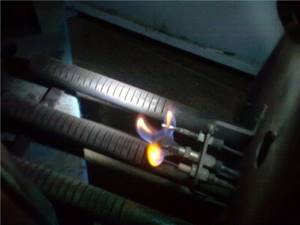
Blowing out the wick is the most common reason why a boiler goes out.
How to identify the problem?
Since the boiler can go out due to all sorts of malfunctions, you can understand that the wind was the cause by the following signs:
- The boiler stops working only in strong winds, but on other days it works properly.

- Oscillation of the burner flame towards the exit, change in its height in the presence of strong wind outside. Normally, external factors do not a priori affect the operation of the boiler and burner in particular.
- A pronounced whistling sound in the combustion chamber, which changes its intensity and severity with different gusts of wind and completely disappears in calm, windless weather.
Expert opinion
Filimonov Sergey Vinokurovich
Heating equipment repairman
I also recommend monitoring such a parameter as gas pressure in the system. If the boiler is set to minimum values, then it is more susceptible to being blown out by the wind than a boiler set to medium values. Often the problem can be solved simply by adding power to the heating system. If this does not help, then you need to consider the situation from all possible sides.
We make sure that the burner goes out due to the wind
In order not to waste efforts in vain, which sometimes happens in practice, it is worthwhile to accurately determine the reasons for the burner extinguishing, since this could be an automatic error, low gas pressure, or difficulties with the removal of combustion products. Characteristic signs of wind blowing are:
- visual changes in the shape and direction of the flame caused by the wind;
- characteristic sound of a vortex in the combustion chamber;
- the burner does not turn off without reason in calm weather, be sure to check this item!
A common cause of fading is low gas pressure in the line or incorrect flame height. At low gas pressure, the flame decreases and drops critically low to the burner. To prevent it from burning out, the automation turns off the burner and the boiler goes out. The normal flame height is considered to be 2-4 cm. If the burner flame height is less, it is necessary to adjust it, but we do not recommend doing this yourself; for this it is better to call the gas service.
It is also necessary to check the tightness of the connections and the entire chimney structure. First of all, if there is an inspection hole in the chimney, pay attention to it: it must be closed and hermetically sealed. If this is not possible, it is worth purchasing a modern sealed plug.
Boilers with coaxial chimney
If a gas boiler has a side chimney (usually in apartments) and goes out due to strong gusts of wind, the main reason lies in the formation of condensation and ice. In practice, the situation is as follows: when exhaust gas exits into the pipe, it cools very quickly and settles on the internal walls in the form of an ice crust, which rapidly increases in thickness.
Outwardly, this does not manifest itself in any way, with the exception of a few icicles hanging outward from the pipe, but in reality the natural removal of waste products is disrupted, which negatively affects the operation of the boiler itself. Whirls are created that lead to oxygen starvation of the gas chamber, and accordingly the gas combustion process is disrupted or completely stopped.

The problem often occurs in regions where winter temperatures are more than -30°C. Experts recommend installing insulation on the outside of pipes to minimize condensate icing. In case of significant ice accumulations, mechanical defrosting using special devices is required, so it is better to call the gas service to solve this problem.
If the design features of a boiler with a side chimney do not require a deflector, then you should install it yourself. This is necessary in cases where the number of windy days per year is more than 200. A device that cuts off vortex air flows. Installed on the air intake pipe.
Solving the problem for different types of boilers
Equipment with a closed burner is called turbocharged and requires electricity to operate. To prevent damage to the control board during power failures, a voltage stabilizer is installed when installing boilers.
Boiler units with an open combustion chamber are called atmospheric . They are independent of the power supply system.
Thus, atmospheric and turbocharged boilers have different designs. Therefore, the principles for solving the problem of their attenuation will also differ.

Atmospheric boilers are energy independent. But in a turbocharged engine, the cause of burner extinguishing may be a problem in the electronic part, and not just blowing wind
In atmospheric boilers the draft is natural. The device does not receive the set volume of air if it is insufficient or there is insufficient air flow. It is necessary to artificially increase the volume of oxygen taken in by installing additional supply ventilation and a regular hole in the door with a grill.
You can also use one of the following methods:
- reducing the diameter of the chimney by installing an internal pipe, which will speed up heating and eliminate the effect of excessive dilution of gas with air;
- installation of a deflector;
- increasing the length of the chimney.
Turbocharged boilers are more stable in operation, but only if they are installed on the leeward side.
In the opposite situation, installing a deflector or reconstructing the chimney by creating a “draft break” - constructing a zone inside the chimney that prevents the reverse movement of combustion products.
Increasing the length of the chimney
Increasing the height of the chimney is appropriate when there are other buildings or tall trees near the house that affect the draft in the chimney. The procedure involves putting several pipes with a cross-section 0.5 larger than the chimney itself onto the existing chimney pipe. It is important to remember that the height of the chimney depends entirely on the roof structure and the power of the boiler.

The average height of the chimney from the boiler grate is 5-6 m. This value can be increased taking into account the roof surface.
Only professionals should carry out work to increase height, as there is a risk of getting the opposite effect:
- A high chimney provokes increased draft, so most of the heat will literally “fly out into the chimney.”
- The amount of condensate increases, which at subzero temperatures will freeze on the inner wall of the chimney. This is fraught with disruption of natural air exchange and automatic shutdown of the gas supply.
Expert opinion
Filimonov Sergey Vinokurovich
Heating equipment repairman
I recommend installing traction stabilizers or dampers, with which you can manually adjust the traction and increase it in especially windy weather.
Rules for constructing a chimney to prevent blowing out
In order not to look for a solution in the future to the question of what to do if a gas boiler goes out due to the wind, study the building codes and rules:
- the location of the upper edge is determined relative to the distance from the roof ridge;
- it must be installed closer to the center, raising it above the maximum level by about 50 cm;
- the total length of the horizontal surfaces of the pipe should not be more than 3 m;
- a maximum of 2 angles/rotations can be introduced into the design;
- choose a rounded cross-section, since a square section reduces the traction force;
- Follow the rule of high-quality thermal insulation.
If the problem of blowing has not been neutralized, then many recommend installing specialized devices:
- deflector that prevents reverse draft;
- a regulator that helps increase the intensity of fuel movement;
- a cone installed on the edge of the chimney will prevent the fire from going out.
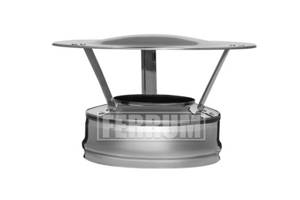
The final factor is competently and accurately calculated system add-ons. It is best to leave the adjustment to a professional.
Deflector installation
The deflector is an aerodynamically shaped nozzle that fits onto the chimney. Made from stainless or galvanized steel.

Performs several functions simultaneously:
- Protects against debris, precipitation and dust getting into the chimney - it has a cone-shaped top.
- Blocks gusts of wind, cutting them off - preventing the vortex from entering the chimney.
- Increases draft by 10-20%, which allows you to solve the problem without increasing the height of the chimney pipe.
The process of installing the deflector will not cause any difficulties, and the effectiveness can be assessed almost immediately. In regions where winds prevail, this design is necessary and is included in the gas heating system.
There are several types of deflectors, each of which has its own characteristics, advantages and disadvantages.
TsAGI

TsAGI
Metal pipe with a shielding cylinder. It has a protective cone inside that prevents blowing from the top and sides.
Advantages:
- Protects from precipitation
- Prevents debris from entering the pipe
- Easy installation
Flaws:
- In severe frosts it provokes the formation of heavy ice
Grigorovich deflector

Grigorovich deflector
A truncated cone with a widening at the base and a mushroom-shaped lid at the top. The air flow enters under the top cover, discharging the air and increasing traction.
Advantages:
- Protects against debris and precipitation
- Relatively low cost
Flaws:
- Not effective in low winds
Vane deflector

Vane deflector
Contains a weather vane and several metal canopies that rotate in the direction of the wind.
Advantages:
- Enhances natural cravings
- Protects against blowing from all sides
- Blocks sediment from entering
Flaws:
- Not found
Expert opinion
Filimonov Sergey Vinokurovich
Heating equipment repairman
The choice of deflector depends on the power of the gas boiler and the characteristics of the chimney. If it is selected incorrectly, the gas consumption will increase and the heat in the house will decrease. To eliminate this, you need to contact specialists and carry out work in compliance with the recommended standards.
Can a gas boiler blow out?
Many owners of private houses often encounter a similar situation when, in windy weather, under the influence of sudden gusts, the gas boiler simply goes out. This situation is unpleasant; such a problem is fraught with breakdown of heating devices and freezing of the system in severe frost.
Therefore, it is important to understand the root causes why this happens and eliminate them before heating difficulties begin to arise during the high season.
Situations when the boiler goes out due to gusts of wind most often occur when installing a ventilation system with violations
Gradual heating of the boiler
If a gas heating system is used in country houses and has been inoperative for a long time, even weak gusts of wind can cause the flame to die out.
The problem is solved by gradually heating the boiler, namely, first after ignition, set the minimum temperature, after 5-10 minutes add gas, and after 20-30 minutes warm up the chimney at high settings. This will allow the chimney to fully warm up, which will make it easier for the exhaust gas to escape up the chimney.
Prevention and testing methods
We told you why there is backdraft in the stove and what to do to eliminate it, and now we want to share the secret of how to prevent its occurrence. There is no secret in this, you just need:
- clean the chimney in a timely manner;
- regularly heat the system so that it does not stand idle;
- eliminate sources of drafts in residential premises;
- monitor the condition of devices installed on the pipe.
We have already described the testing methods in the section on identifying the problem, so here we will mention cases in which it is worth carrying out tests with a candle, paper or an anemometer. This should be done when the house has not been heated for a long time, there is (or has recently been) bad weather outside - heavy rain, blizzard, gusty wind, thick fog - and you want, for example, to light a fireplace. This is also true if the rooms, despite the kindling, are cold, or you suspect a malfunction.
General tips and tricks

If the gas boiler is blown out by the wind, pay attention to the following nuances:
- Check to see if the boiler is operating at minimum temperatures. It makes sense to add gas by 20-30% to enhance natural traction.
- Be sure to call specialists who will not only find the problem, but also diagnose the entire heating system.
- Clean the chimney in a timely manner, as contaminants can form inside over time.
It is not recommended to independently inspect the combustion chamber, change burner parameters or adjust the operation of control sensors. This may lead to problems in the future. All work related to gas equipment must be carried out by qualified specialists.
Solutions if the boiler goes out in the wind
Changes in gas pressure do not occur very often. Moreover, the differences are so insignificant that they are unlikely to be the reason. Don't immediately look for a hardware problem. The design of the latest models of gas boilers is quite simple, but at the same time reliable.
The most commonly found deficiencies are:
- Formation of an ice clod that blocks the ventilation channel. It prevents the exchange of air particles that enables combustion. The appearance of ice is a natural phenomenon, because in addition to spent fuel, condensate penetrates into the pipes. It just freezes on the walls.
- Backdraft, which occurs due to strong and gusty winds, as well as during a sudden change in movement. It moves along the entire length of the structure and eventually reaches the boiler. The flame in it goes out.
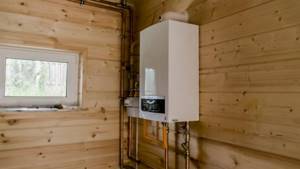
Ice is an artificial obstacle, and its formation means that the structure was assembled incorrectly. To correct errors, you must immediately stop using the oven and contact a specialist. They will clean the pipe, install a condensate drain (umbrella, canopy) or a walk-through collector.
Backdraft is a great danger due to the extinguishing of the burner flame. The system in the latest generation boiler equipment is more modern. The automatic system quickly operates and stops supplying gas to the firebox. However, combustion products first enter the heating installation, thereby polluting the chamber. During subsequent switching on, they will penetrate inside. The reason for this phenomenon is most often the insufficient length of the chimney. To correct the situation you need:
- Structural changes.
- Installation of the stabilizer (thrust regulator).
- Installation of the deflector.
- Connection of (rotary) gate.
Frequently asked questions and answers
The boiler is blown out by the wind, and the smell of gas is felt in the room. What is this connected with?
There may be a problem with the backdraft valve, but to be sure, it is necessary to inspect the injector burner. Attention should also be paid to control sensors. Over time, they fail and are not able to timely generate a signal about the need for an emergency shutdown of gas supply to the system, which is where the characteristic odor appears.
The flame in the burner is unstable, fluctuates with any gust of wind, often goes out, the temperature in the system drops, what could be the problem?
This is characterized by an increase in natural cravings, for which there are many reasons. It is necessary to inspect the hood, as well as the burner itself, adjusting the gas supply and flame height. If there are strong gusts of wind outside and the problem with attenuation occurs very often, a deflector is installed on the hood (chimney) to cut off vortex air flows.
In conclusion, it is worth noting that the problem with the boiler blowing out periodically occurs among residents of apartment buildings. As for private mansions, attenuation is caused by improper chimney design or insufficient draft.
In resolving the issue, it is important to make sure that the burner and control sensors are in good working order, since they can indirectly contribute to stopping the combustion process. All work must be performed by qualified specialists.
Ways to combat backdraft
If a gas boiler goes out in strong winds, then enlarging the chimney pipe is the easiest way to combat backdraft. But this solution has its drawbacks.
The second option for solving the problem of what to do if the boiler blows out is to install a deflector on the upper edge of the chimney pipe. This element helps to increase draft in the chimney channel.
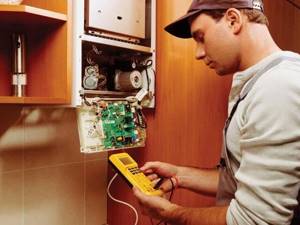
Another solution to the problem of what to do when the wind blows out a gas boiler is to install a chimney with a minimum number of bends and turns. In this case, the turbulence of the air flow with combustion products as it passes through the pipe is reduced. Many people install a flueless gas water heater, which does not have these problems.
However, in all cases the problem cannot be solved completely. The effect of lengthening the chimney pipe does not live up to expectations, and a simple deflector partially solves the situation when the boiler goes out in the wind. Therefore, it is necessary to look for a more effective method that will not allow strong winds to damage heating and heating equipment.
Installation of the "fungus"
Sometimes, in order to solve the problem, such a simple measure as installing a “fungus” on the end of the pipe is enough. This simple device reduces the likelihood of backdraft. There are several types of fungi:
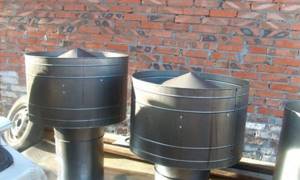
- cone-shaped;
- in the shape of a ring, larger in diameter than the chimney;
- combined, consisting of a ring and a cone.
Fungus functions:
- dispersion of directed air flow;
- creation of vortices, due to which reverse thrust does not develop.
Advice! To choose the optimal shape of the “fungus”, you should consult with a specialist, since in some cases installing a “fungus” of the wrong shape leads to the formation of ice in the chimney.
Increasing the pipe height
Another solution to the problem could be to increase the height of the chimney to increase the draft force. Sometimes this has to be done after several years of normal operation of the boiler due to an obstacle that has appeared. For example, if a taller building or other high-rise object is built next to the house.
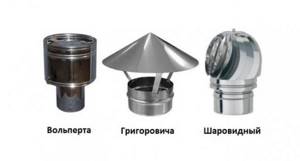
"Break traction"
If it is impossible to increase the height of the chimney, it is worth trying to organize a so-called “draft break”. To do this, a special device is inserted into the pipe, which prevents the formation of backdraft.
The simplest version of the device has the shape of a truncated cone; it is installed with the wide end towards the boiler. The point of installing such a device is that the air flow entering the pipe loses its strength and forms turbulence, since it cannot freely pass through the narrow part of the cone.
Advice! It is prohibited to install any additional devices in the chimney without the permission of specialists. Please note that incorrectly selected devices for “draft breaking” can lead to a deterioration in natural draft and the entry of carbon monoxide into the premises of the house.
Reduce the diameter of the chimney
Many people believe that the larger the diameter of the chimney, the better the natural draft. But this is a wrong opinion; moreover, too large a chimney diameter can lead to the burner being blown out by the wind. Why is this happening? The fact is that to create enough thrust, three conditions must be met:
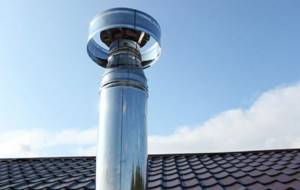
- supply of sufficient air to the firebox to ensure combustion processes;
- achieving a high temperature in the current for the most complete combustion of flue gas;
- heating the inner walls of the chimney pipe.
In order to fulfill the last condition, the inside of the chimney must be assembled from materials with low thermal conductivity. It is clear that the larger the internal diameter of the chimney, the longer it will take to heat them up.
That is, the cause of poor boiler performance can be not only the entry of air flows into the pipe and the creation of reverse draft, but also the insufficient force of forward draft due to the fact that the internal walls of the chimney pipe do not have time to warm up.
To solve this problem, you do not need to disassemble the old chimney; just insert a pipe of a smaller diameter into it. In this case, heating of the inner walls will occur much faster, this will increase the force of direct thrust.
